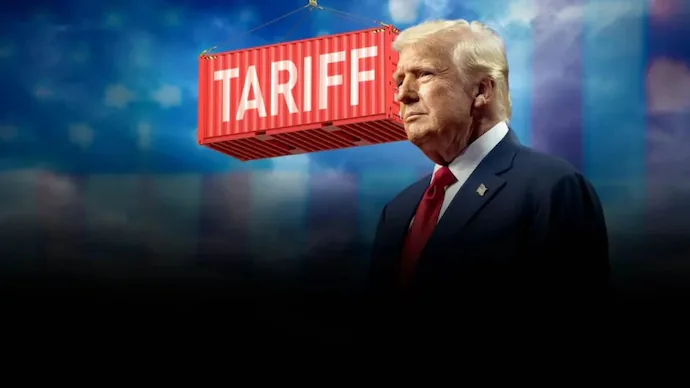Introduction to Trump’s announcement of a tariffs pause
In a surprising turn of events, President Trump has announced a pause on tariffs that have kept investors on edge for months. This unexpected move sent shockwaves through the financial markets, resulting in significant gains across various sectors. As traders scramble to interpret what this means for the economy and global trade relations, many are left wondering how such a decision could reshape their investment strategies.
With uncertainty now giving way to optimism, let’s dive deeper into what tariffs really are and how this latest announcement is poised to impact industries and stock prices alike.
Explanation of what tariffs are
Tariffs are taxes imposed by governments on imported goods. They serve as a tool to regulate trade between nations. When a country levies tariffs, it makes foreign products more expensive.
This can lead to a shift in consumer behavior. Domestic products may become more appealing due to lower costs compared to their taxed counterparts. Businesses often face mixed reactions; some benefit while others struggle with increased production costs.
Governments use tariffs for various reasons, such as protecting local industries or generating revenue. However, they can also escalate tensions between countries and provoke retaliatory measures.
In essence, tariffs play a significant role in shaping international commerce and economic relationships across the globe. Understanding their implications helps clarify why announcements like Trump’s pause resonate so widely among investors and consumers alike.
Impact on the stock market
The announcement of a tariffs pause by Trump sent ripples through the stock market, igniting investor enthusiasm. Major indices surged as traders reacted positively to the news.
Stocks in sectors directly impacted by trade tensions saw significant gains. Companies that had been fearful of rising costs suddenly found reprieve. The tech and manufacturing industries were among the most responsive, benefiting from decreased uncertainty.
Market analysts noted a wave of optimism sweeping through Wall Street. Investors felt reassured about corporate earnings potential without looming tariff hikes.
In addition, this move fueled discussions around economic stability. Many viewed it as a signal for renewed confidence in consumer spending and business investment.
As prices climbed, trading volume increased significantly as more investors jumped on opportunities created by the favorable shift in policy direction.
Industries and companies affected by tariffs
Tariffs have a ripple effect across various industries. The manufacturing sector often feels the brunt, especially those relying on imported raw materials. Higher costs can lead to increased prices for consumers.
The technology industry also faces challenges with tariffs on components like semiconductors. Companies that depend on these parts may struggle to maintain profit margins while competing in a global market.
Retailers are not left unscathed either. Products sourced from countries affected by tariffs may see price hikes, which could dampen consumer spending during crucial sales periods.
Automakers face unique pressures as well. Tariffs impact both the cost of parts and finished vehicles, forcing them to make tough decisions about pricing strategies or even production locations.
Agriculture stands out in this landscape too. Farmers exporting goods might find their markets shrinking due to retaliatory tariffs imposed by other nations, complicating an already challenging environment for agriculture workers.
Pros and cons of the tariffs pause
The pause on tariffs brings several benefits. For consumers, it could mean lower prices on imported goods. This can enhance purchasing power and stimulate spending.
Businesses also stand to gain from reduced uncertainty in trade policies. Companies can plan better without the looming threat of new tariffs impacting their bottom line.
However, there are downsides too. Industries that rely heavily on protectionist measures may struggle if competition increases. Domestic manufacturers might find themselves under pressure as cheaper imports flood the market.
Additionally, some investors fear that this pause could signal a lack of commitment to long-term trade reform. It raises questions about future negotiations and potential volatility in international relations.
Balancing these pros and cons will be crucial for economic stability moving forward. The real test lies in how various sectors adapt to these changes over time.
Reactions from experts and investors
Experts reacted with cautious optimism to Trump’s announcement of a tariffs pause. Many viewed it as a potential catalyst for renewed economic stability. Tariffs have created uncertainty, and reducing them might ease some tensions.
Market analysts highlighted the immediate uptick in stock prices. Investors seemed relieved, signaling confidence that trade relations could improve.
However, not all responses were positive. Some economists warned that this pause might merely delay long-term challenges rather than resolve them. They pointed out that industries still face underlying issues from previous tariff implementations.
Investors remained split on their outlooks. While some celebrated the news by buying into affected sectors like technology and manufacturing, others opted for caution, closely monitoring international developments before making further commitments.
The mixed sentiments reflect a broader anxiety about future policy shifts and their implications for global markets moving forward.
Future implications and predictions
The pause on tariffs could signal a shift towards more stable trade relations. Investors are keenly watching how this affects global supply chains.
Some analysts believe that the move will lead to increased consumer confidence. This, in turn, might drive spending and boost economic growth.
However, uncertainties linger. Will industries adjust quickly enough to capitalize on this pause? If tensions resurface later, the initial optimism may fade fast.
Moreover, geopolitical factors can’t be ignored. Different countries may react unpredictably based on their own interests and strategies.
Long-term predictions remain tricky. While some sectors might flourish immediately after the announcement, others could take longer to adapt or face new challenges ahead.
Market volatility is still a concern as investors weigh potential outcomes of future negotiations and policies. The landscape is dynamic; only time will reveal its true impact.
Conclusion
The recent announcement of a tariffs pause by Trump has sent ripples through the financial landscape. Investors are breathing a sigh of relief as they witness markets soar, reflecting optimism and renewed confidence in economic stability. The move signifies an attempt to de-escalate trade tensions that had been weighing heavily on various sectors.
Understanding what tariffs are sheds light on their broader implications. Tariffs are taxes imposed on imported goods, aimed at protecting domestic industries but often leading to increased prices for consumers and retaliatory measures from other nations. The potential for a halt in these tariffs could mean cheaper imports and a boost for companies reliant on global supply chains.
Many industries have felt the impact of tariffs over the past years, with manufacturing, agriculture, and technology being hit particularly hard. Companies like Boeing, Caterpillar, and agricultural giants have faced uncertainty as costs fluctuated due to ongoing trade disputes.
There are both pros and cons associated with this pause in tariffs. On one hand, it offers immediate relief to businesses struggling under pressure from high import costs. It might also clarify future trade policies that can drive investment decisions moving forward. On the flip side, some experts warn about complacency; without permanent solutions or agreements in place, volatility may return sooner than expected.
Reactions from investors have generally leaned positive following Trump’s announcement; stock prices surged across multiple indices as hope returned after months of turmoil created by tariff-related uncertainties. Financial analysts express cautious optimism but remain vigilant about how this development will play out globally.
Looking ahead reveals mixed predictions among industry insiders regarding future implications stemming from this decision. Some believe it signals brighter days for U.S.-China relations while others fear political maneuvering could reignite conflict down the road if negotiations falter again.
As we navigate this ever-changing landscape shaped by policy decisions such as Trump’s tariff pause, staying informed is crucial—both for investors looking to capitalize on opportunities and industries eager to adapt swiftly amid shifting tides.





